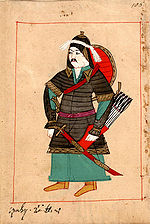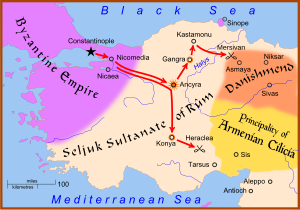Kilij Arslan I

Kilij Arslan (Arabic: قلج أرسلان, Qilij Arslān; Turkish: I. Kılıç Arslan) was the Seljuq Sultan of Rum from 1092 until his death in 1107. He ruled the Sultanate during the time of the First Crusade and thus faced the brunt of the entire attack.[1] He also re-established the Sultanate of Rum after the death of Malik Shah I of Great Seljuk and soundly defeated the Crusaders in three separate battles during the Crusade of 1101 which arose as a well-managed response to the First Crusade.[2]
Rise to Power
After the death of his father, Suleyman, in 1086, he became a hostage of Sultan Malik Shah I of Great Seljuk, but was released when Malik Shah died in 1092. Kilij Arslan then marched at the head of the Turkish Oghuz Yiva tribe army and set up his capital at Nicaea, replacing Amin 'l Ghazni, the governor appointed by Malik Shah I.
Following the death of Malik Shah I the individual tribes; the Danishmends, Mangujekids, Saltuqids, Chaka, Tengribirmish begs, Artuqids (Ortoqids), and Akhlat-Shahs; had started vying with each other to establish their own independent states. Alexius Comnenus's Byzantine intrigues further complicated the situation. He married the daughter of the Emir of the Chaka to attempt to ally himself against the Byzantines, who commanded a strong naval fleet. In 1094, Kilij Arslan received a letter from Alexius suggesting that the Chaka sought to target him to move onto the Byzantines, thereupon Kilij Arslan marched with an army to Smyrna, Chaka’s capital, and invited his father-in-law to a banquet in his tent where he slew him while he was intoxicated.
The Crusades

People's Crusade
The Peasants' Crusade army of Peter the Hermit and Walter the Penniless arrived at Nicaea in 1096. Kilij Arslan's army easily defeated the mob and about 30,000 Crusaders were killed and the rest were sold into slavery. He then invaded the Danishmend Emirate of Malik Ghazi in eastern Anatolia.
First Crusade
Because of this easy first victory he did not consider the main crusader army, led by various nobles of western Europe, to be a serious threat. He resumed his war with the Danishmends, and was away from Nicaea when these new Crusaders besieged Nicaea in May of 1097. He hurried back to his capital to find it surrounded by the Crusaders, and was defeated in battle with them on May 21. The city then surrendered to the Byzantines and his wife and children were captured. When the crusaders sent the Sultana to Constantinople, to their dismay she was later returned without ransom in 1097 because of the relationship between Kilij Arslan and Alexius Comnenus.
As result of the stronger invasion, Rüm and the Danismends allied in their attempt to turn back the crusaders. The Crusaders continued split their forces as they marched across Anatolia. The combined Danishmend and Rüm forces planned to ambush the Crusaders near Dorylaeum on June 29. However, Kilij Arslan's horse archers could not penetrate the line of defense set up by the Crusader knights, and the main body under Bohemund arrived to capture the Turkish camp on July 1. Kilij Arslan retreated, however, afterwards, inflicted heavy losses to the Crusader Army with guerilla warfare and hit-and-run tactics. He also destroyed crops and water supplies along their route in order to damage logistical supplying of the Crusader Army.
- See also: Siege of Nicaea, Battle of Dorylaeum
Crusade of 1101

Ghazni ibn Danishmend captured Bohemund resulting in a new force of Lombards attempting to rescue him. In their march the took Ankara from Arslan upon the Danishmends. In alliance with Radwan the Atabeg of Aleppo he ambushed this force at the Battle of Mersivan. In 1101 he defeated another Crusader army at Heraclea Cybistra, which had come to assist the fledging Crusader States in Syria. This was an important victory for the Turks, as it proved that an army of Crusader knights were not invincible. After this victory he moved his capital to Konya and defeated a force led by William II of Nevers who attempted to march upon it as well as the subsequent force a week later.
In 1104 he resumed once more his war with the Danishmends who were now weakened after the death of Malik Ghazi, demanding half the ransom gained for Bohemund. As a result Bohemund allied with the Danishmends against Rüm and the Byzantines.
War and death in Syria
After the crusades he moved towards the east taking Harran, and Diyarbakr. In 1107 he conquered Mosul, but he was defeated by Emir Jawali al-Saqawu for Mehmed I of Great Seljuk supported by the Ortoqids and Fakhr al-Mulk Radwan of Aleppo at the Battle of Mosul. Kilij Arslan died in his capital.[3]
